Introduction to the Disrupt Competency
The discipline of Experience Management (XM) is about much more than simply identifying existing problems and responding to explicit feedback. While these activities may allow an organization to deliver satisfactory experiences, they’re not going to help it create experiences that capture the hearts and minds of the people who interact with it. And in a world where new products, services, and capabilities rapidly become commoditized, forging these strong emotional bonds is increasingly essential for earning people’s long-term loyalty. The organizations that will survive are the ones that are capable of discovering, designing, and deploying innovative, engaging experiences that set them apart from competitors.
These efforts can’t just happen sporadically or in isolated instances. They need to be an ongoing motion, embedded into the organization’s strategy, culture, and operating processes. To establish these capabilities, brands should develop the skills and actions associated with the Disrupt Competency – one of the Six XM Competencies that are foundational to the discipline of Experience Management. This particular Competency is about:
Identifying and creating experiences that differentiate the organization.
When organizations develop the skills and actions associated with the Disrupt Competency, they will be able to:
- Build deep emotional connections. XM Institute research shows that how people feel about their experiences with an organization has the most significant impact on their loyalty to that organization. The Disrupt Competency helps brands establish the practices, skills, tools, and processes necessary to consistently design and deliver the type of emotionally resonant experiences that will build long-term bonds between the organization and people across its ecosystem, including customers and employees.
- Satisfy unmet – and often unexpressed – needs. While an organization may be able to incrementally improve its interactions just by capturing and responding to feedback, these activities will never lead to truly transformative experiences. People are not always able to articulate their true desires, needs, goals, and motivations or tell an organization what it would take to surprise or delight them. As Henry Ford – the inventor of the car – once said, “If I would have asked the people what they wanted, they would have said faster horses.” Mastering the Disrupt Competency allows organizations to develop a deeper understanding of people’s unmet and unvoiced wants and needs and then translate those latent desires into opportunities for innovative products, services, and experiences.
- Systematically innovate new or improved experiences. Creating differentiated experiences is hard and often requires brands to operate in a way that is antithetical to how organizations and their leaders typically conduct business. Innovation requires creativity, an acceptance of failure, and active questioning of existing strategies and norms. However, the skills, tools, and approaches associated with the Disrupt Competency provide organizations with systematic methods they can follow to identify and design breakthrough experiences. They anchor the more creative and “squishy” parts of the innovation process in repeatable and scalable frameworks, approaches, and practices, ultimately ensuring that these innovation efforts are viable from a business and technological standpoint.
- Deliver experiences in a consistent fashion. Organizations today tend to follow what can generously be described as a “haphazard” approach to identifying, designing, and delivering new or improved experiences. Not only do they not typically follow a repeatable process for crafting interactions, but operational issues like information silos, unclear processes, and lack of internal enablement often lead to dramatic differences between experiences produced by different areas of the business. Building the skills and practices associated with the Disrupt Competency will help brands design and deploy experiences that are consistent and on-brand, no matter where they originate from or occur across the organization.
Mastering the Three Skills of the Disrupt Competency
The practices, tools, and approaches associated with the Disrupt Competency – including methodologies such as Design Thinking and Human-Centered Design – will help organizations identify, create, and deliver – not just satisfactory interactions – but truly innovative experiences that emotionally engage people across their ecosystem and set them apart from their competitors. So how exactly should brands go about strengthening their capabilities in this area? By focusing on developing three XM Skills associated with Disrupt:
- Experience Visioning. Before you can design breakthrough experiences, you first need to understand who you’re creating these experiences for, what their current engagements with your organization look like, and where to focus your improvement efforts. This Skill is about uncovering opportunities for disruptive experiences.
- Experience Design. After pinpointing opportunities for innovative experiences, you then need to design and develop solutions that address those opportunities. This Skill is about applying a repeatable, human-centric approach to create or improve experiences.
- Experience Integration. No matter how innovative a new experience is, it will ultimately fail if the organization is not capable of supporting it. This Skill is about developing the processes, systems, and training to enable the organization to deliver new experiences in a consistent fashion.
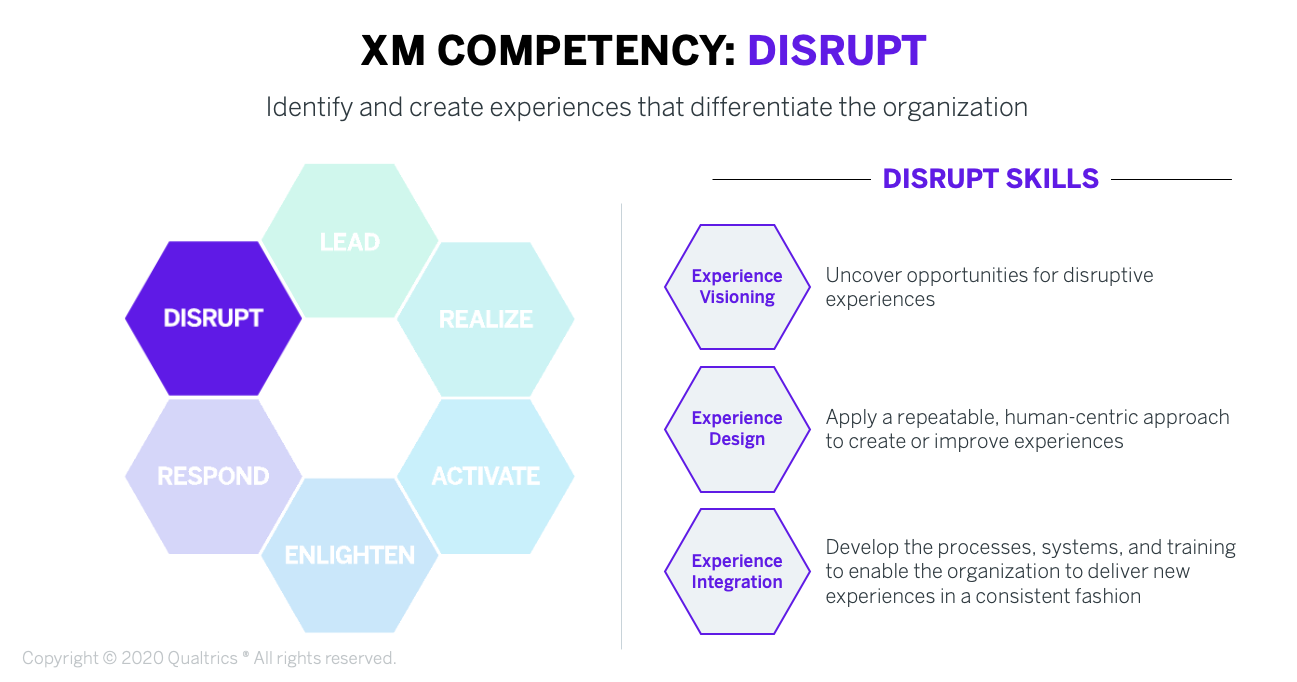
XM Skill: Experience Visioning
There is a natural disconnect between the people who create experiences and the people who consume experiences. Those creating experiences are inherently well-versed in their organization’s products, services, interactions, benefits, and journeys and more familiar with the organization’s structures, operating processes, and jargon. While this internal, company-centric perspective may be natural, it tends to blind experience designers to areas where there are not only frustrations and inefficiencies, but also untapped opportunities for creating truly transformative experiences.
So before a brand can craft innovative interactions, the team responsible for creating or improving these experiences needs to clarify who exactly they are designing for and what their engagements with the organization both currently look like and should ideally look like. To do this consistently at scale, organizations need to hone the Skill of Experience Visioning, which is about uncovering opportunities for disruptive new experiences. Here are some practices brands should adopt to build this Skill 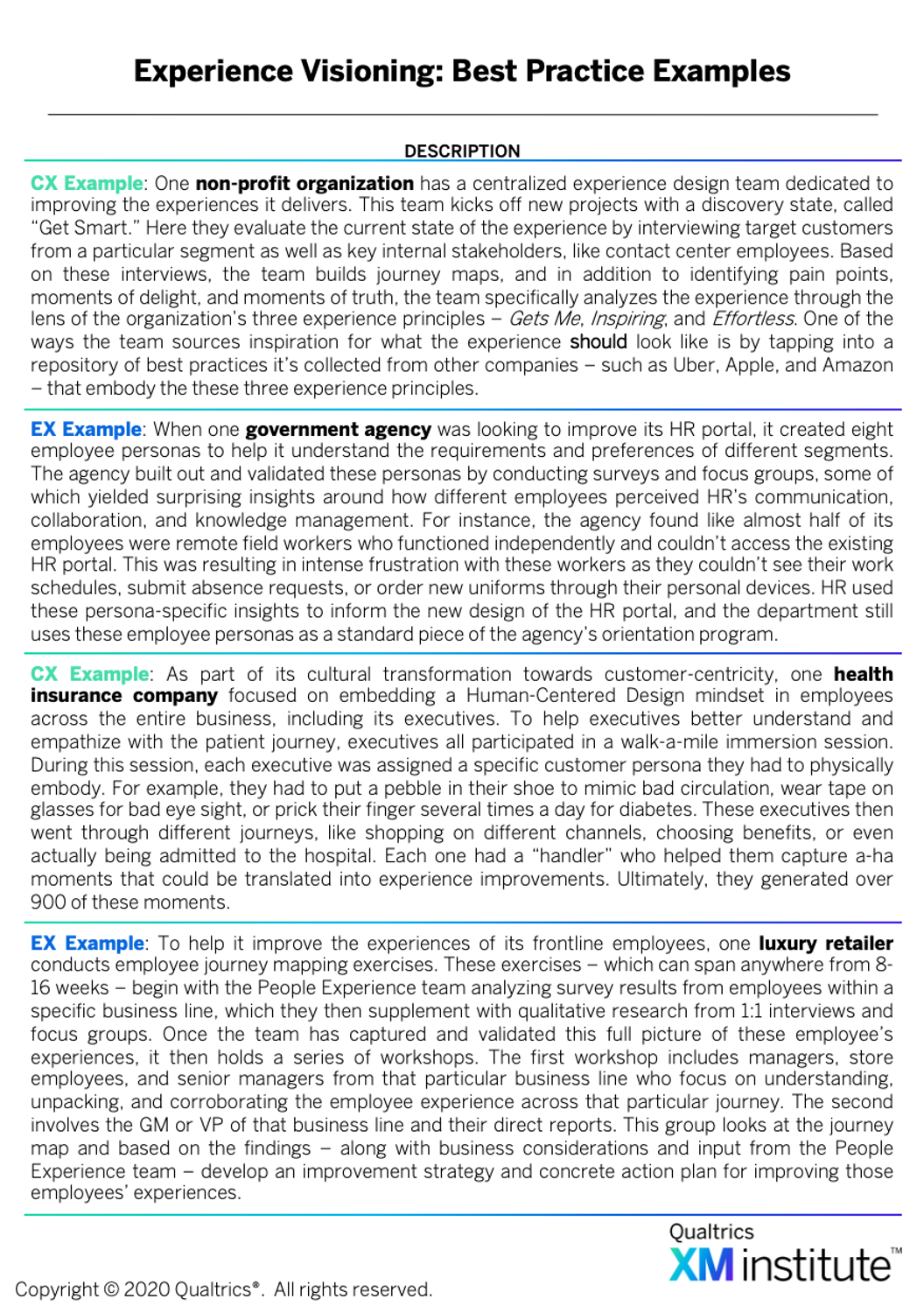 :
:
- Identify a clear target audience. An experience designed for everyone will end up satisfying no one. People have different requirements and preferences for what they consider to be an innovative or standout experience, and trying to accommodate everyone’s needs, desires, and tastes will only result in confused or milquetoast interactions that don’t appeal to anyone. So before a project team begins the process of designing a differentiated new experience, it first needs to articulate a clear vision of who exactly the target audience is. Once the team has identified this target user – which should be informed by the organization’s business, brand, and strategy objectives – it then needs to tap into or conduct in-depth qualitative research to develop a sincere understanding of this core segment’s needs, desires, expectations, values, attitudes, behaviors, goals, etc.
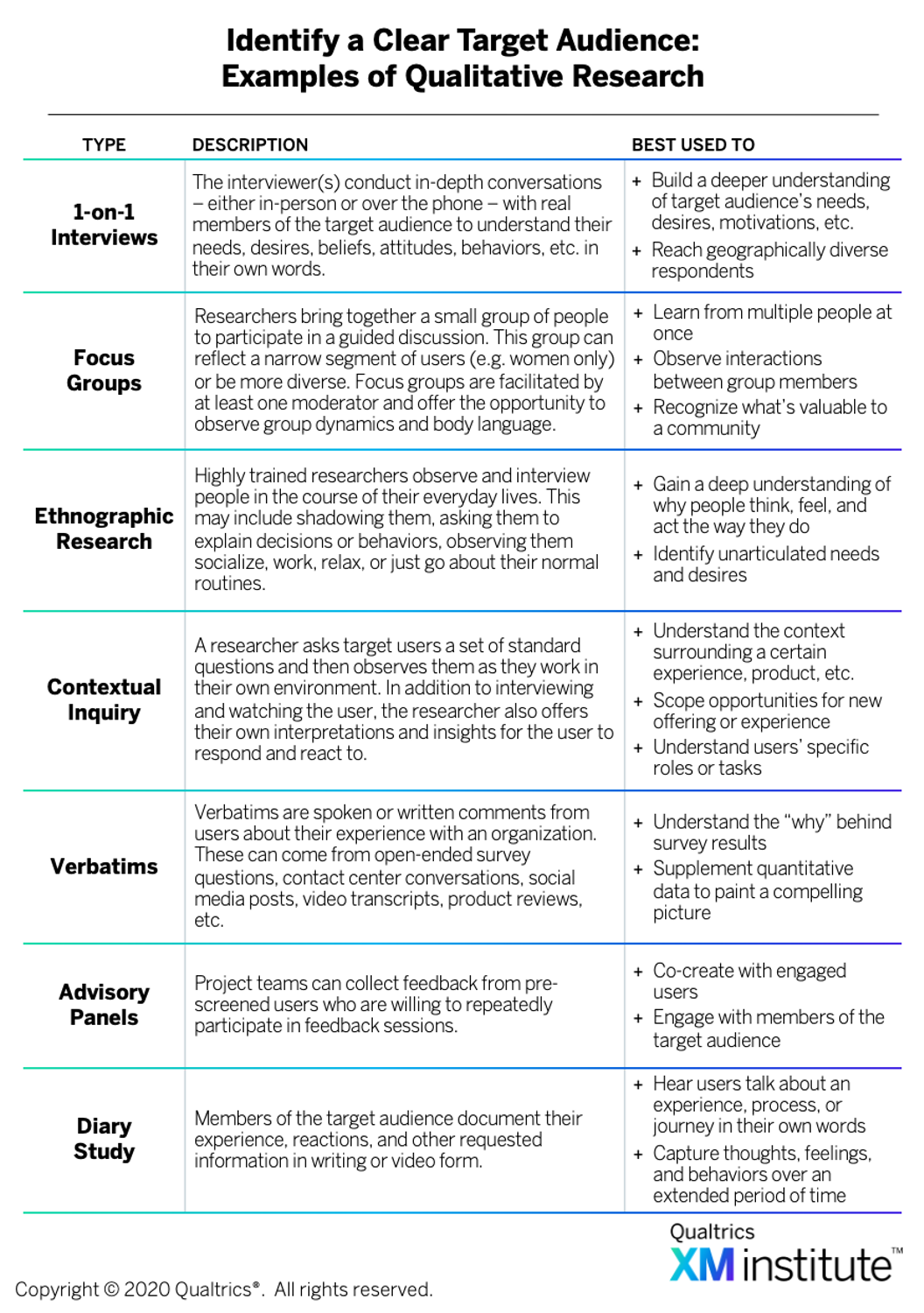 . These characteristics can be codified in personas, which will not only help bring these users to life, they will ensure that everyone shares a common understanding of who the target audience is and how they are likely to feel and behave as they engage with the brand
. These characteristics can be codified in personas, which will not only help bring these users to life, they will ensure that everyone shares a common understanding of who the target audience is and how they are likely to feel and behave as they engage with the brand 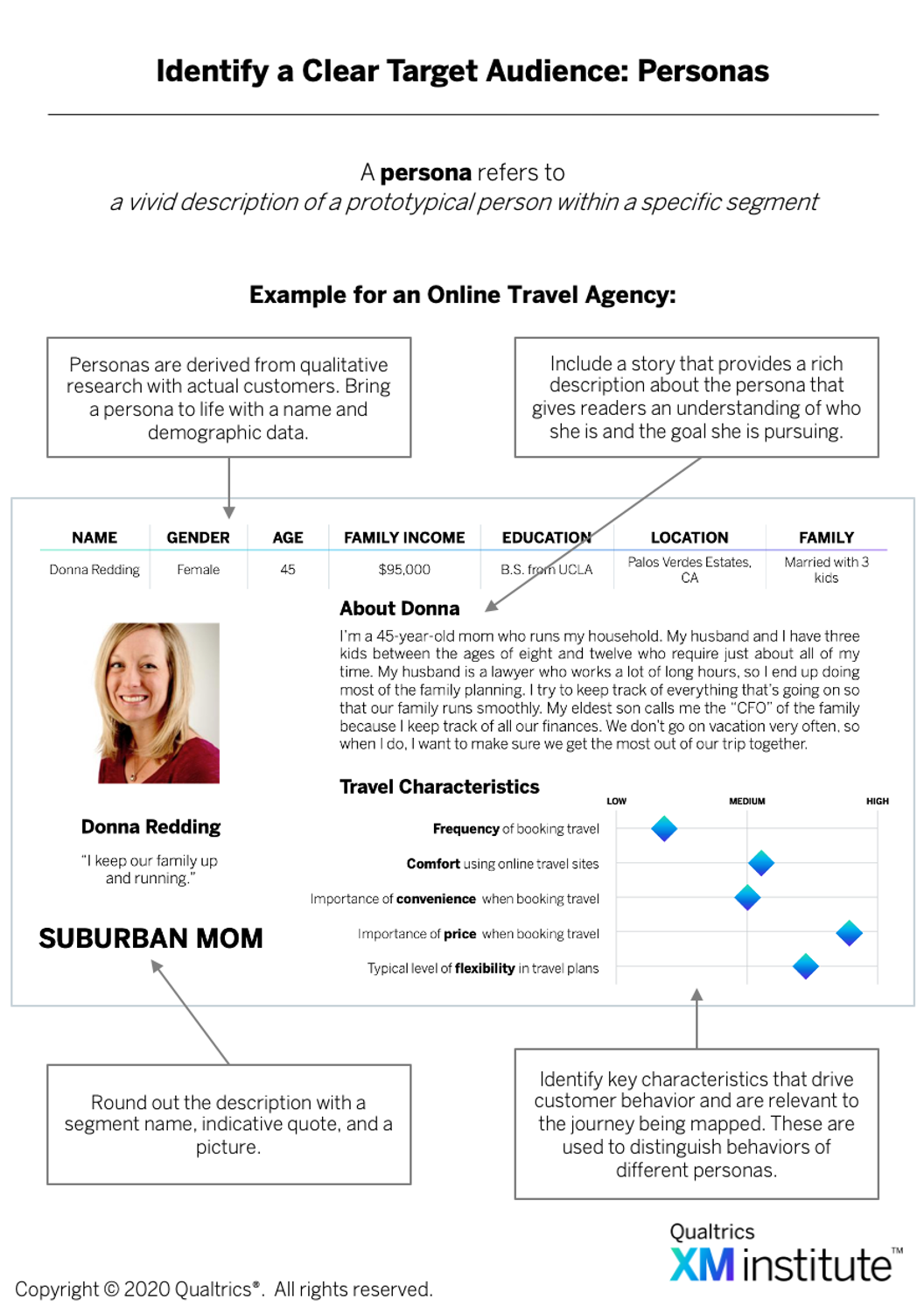 .
. - Understand the current state of journeys. Once the project team has established a deep understanding of the audience they’re designing for, they then need to examine one of their journeys with the brand. Which journey the team focuses on will depend on their audience and objectives, but it needs to encompass more than one or two interactions. People engage with an organization because they are trying to achieve some broader, personal goal, and the path to reaching that goal happens to intersect with the brand at some point along the way. Developing this holistic perspective of the target user’s current journey, therefore, will allow the project team to identify where there are experience gaps they can close, friction points or inefficiencies they can eliminate, or opportunities to address unmet needs or desires. There are a variety of different sources the team can tap into to cultivate this deep understanding, ranging from the relatively simple – such as survey results, social media posts, or frontline feedback – to the more labor-intensive – such as ethnographic studies, immersion sessions, or Journey Mapping projects
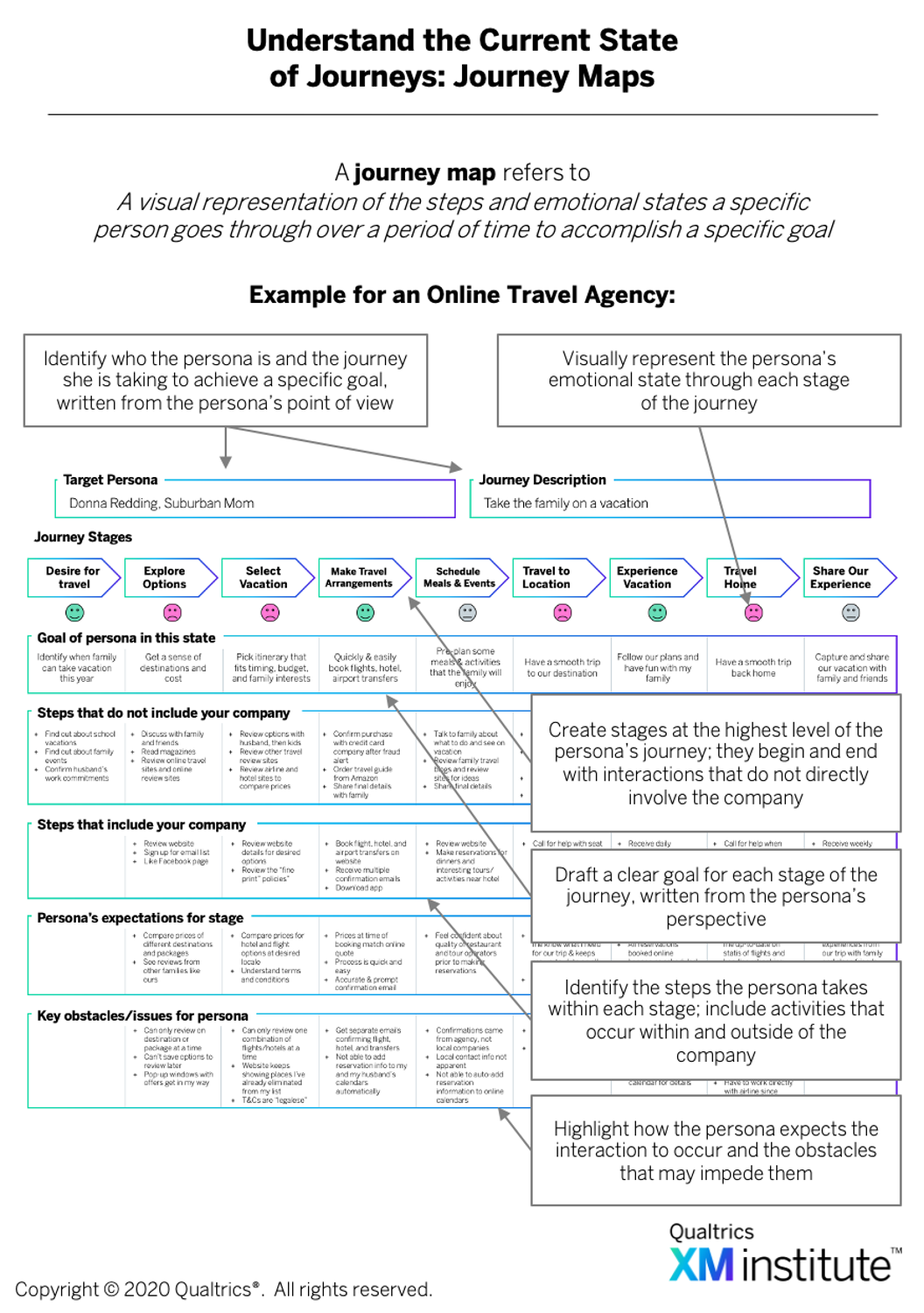 .
. - Articulate the desired future state. After the project team has developed clarity around who their core audience is and what their engagements with the organization currently look like, they then need to define what the future state of their experiences should look like. This requires them to organize and interpret the insights they collected from their qualitative research, combine them with the needs and objectives of the business – as well as any relevant operational data – and then synthesize all this information down into a well-defined vision of what the target audience’s journey with the company will look like at the end of the design process. The output from this activity can take many forms, such as a problem statement outlining the challenge, a fictionalized future headline describing the new experience, or an idealized journey map. Even if the ultimate experience doesn’t precisely match this vision, articulating the desired end state will help scope the problem, guide the ideation process, and keep everyone working toward the same end goal.
XM Skill: Experience Design
Once the project team has pinpointed where opportunities exist for creating disruptive new experiences, it then needs to execute on these opportunities by designing experiences that will emotionally engage their target audience. Although it is possible for an organization to make small, incremental improvements to its products, services, benefits, interactions, and so forth simply by capturing and acting on feedback, designing differentiated experiences requires significantly more effort and creativity. That’s because while people may be capable of listing their definitive complaints, they’re not nearly as capable of articulating what would surprise, delight, or enchant them.
Consequently, it’s up to the people creating these experiences to take what they learned during Experience Visioning and translate those insights into innovative, viable new ideas. That’s where the XM Skill of Experience Design comes in. Developing this Skill will allow an organization to apply a repeatable, human-centric approach to create or improve experiences. Here are some practices organizations should adopt to build this Skill 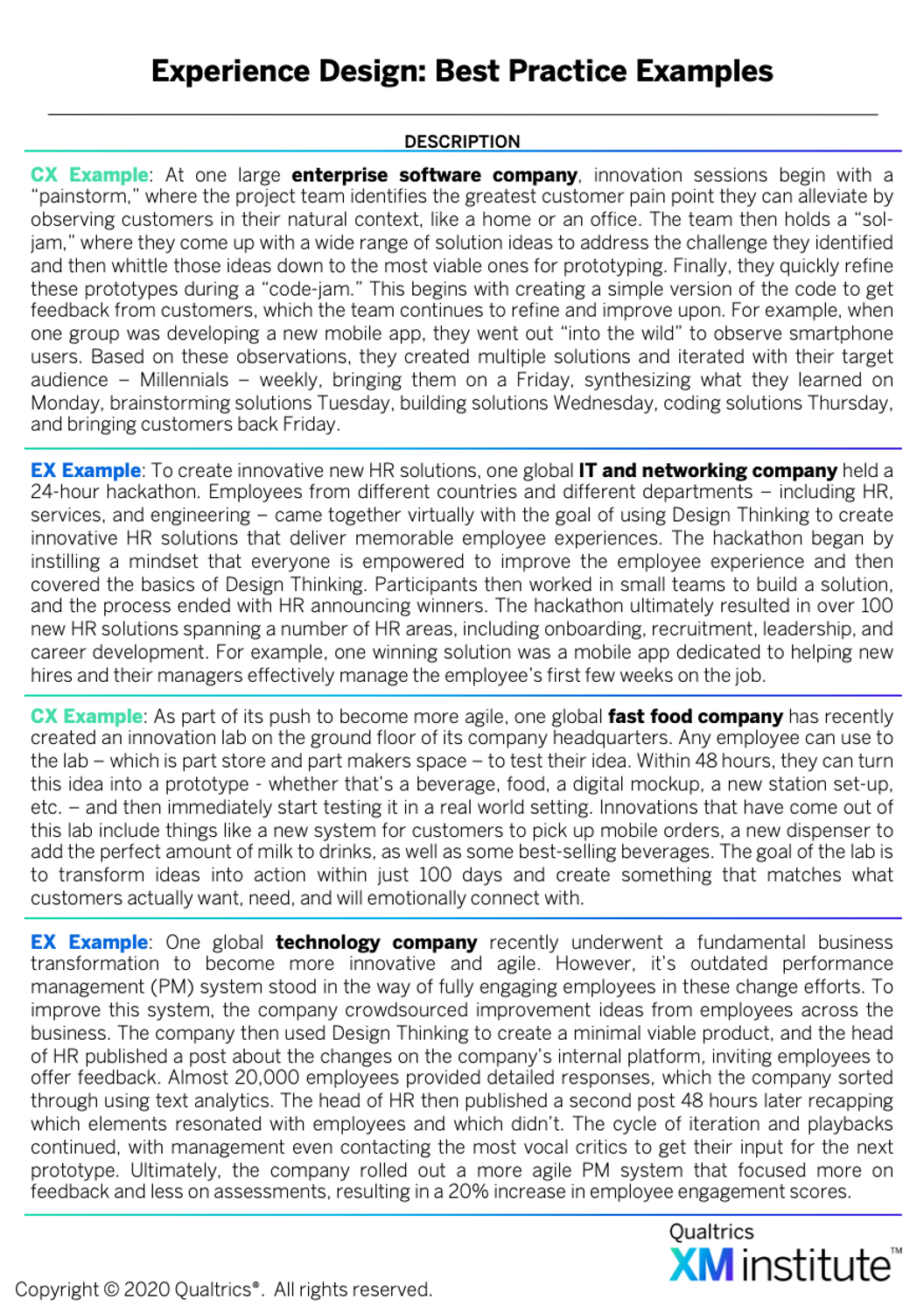 :
:
- Brainstorm potential solutions. The first activity under this Skill is to begin exploring potential solutions for closing the gap between the target audience’s current experience and that ideal future experience outlined under Experience Visioning
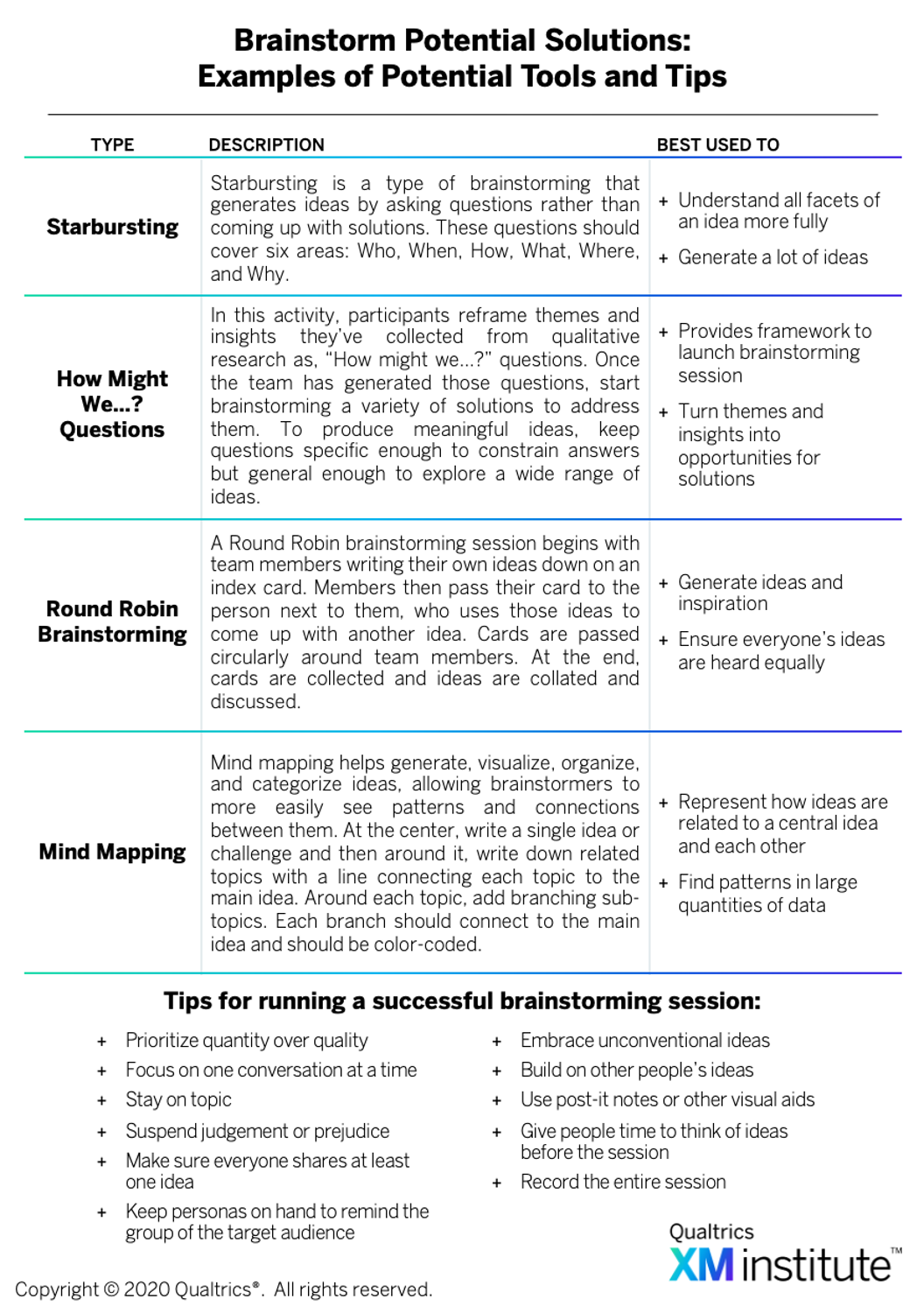 . The goal here is to generate a wide range of possible solutions. So while it’s important that ideas reflect the organization’s brand values and address the needs and preferences of the target user, most of the attention should be around creative and expansive thinking. Ideas and inspiration can be sourced from a number of places, including dedicated brainstorming sessions with the project team, co-creation exercises with the target user or relevant stakeholders, employee-submitted suggestions, advisory panels, other best-in-class brands or experience areas (e.g. customer, employee, brand, or product experience), and even company-wide brainstorming events like hackathons.
. The goal here is to generate a wide range of possible solutions. So while it’s important that ideas reflect the organization’s brand values and address the needs and preferences of the target user, most of the attention should be around creative and expansive thinking. Ideas and inspiration can be sourced from a number of places, including dedicated brainstorming sessions with the project team, co-creation exercises with the target user or relevant stakeholders, employee-submitted suggestions, advisory panels, other best-in-class brands or experience areas (e.g. customer, employee, brand, or product experience), and even company-wide brainstorming events like hackathons. - Build low-fidelity prototypes. Once the project team has generated a list of potential solutions, Instead of diving headlong into implementing one of the ideas, they should instead select a few of the most promising experience ideas and begin building them out into inexpensive, low fidelity prototypes
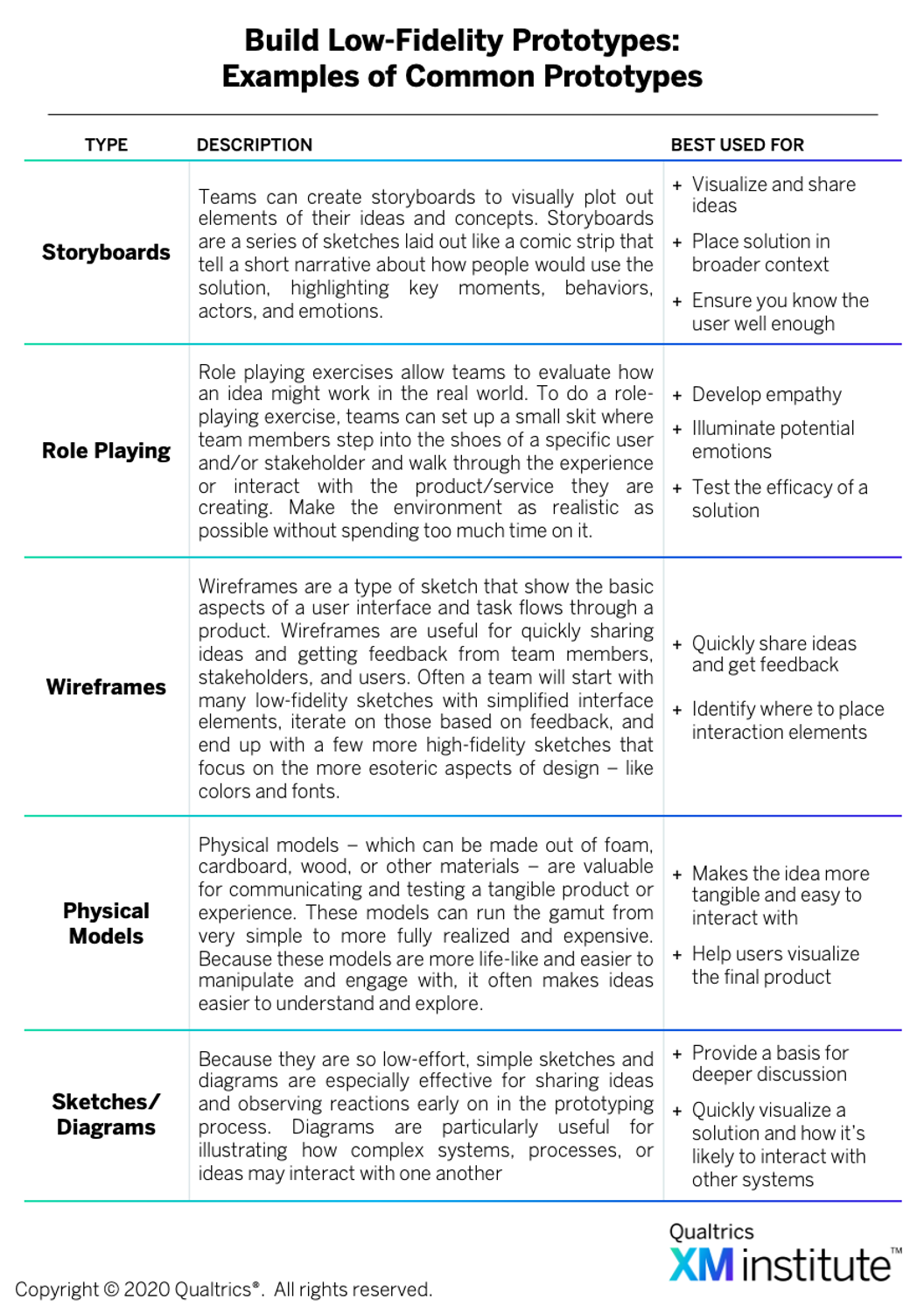 . The exact form of these prototypes will vary depending on the type of experience you are working on – they could be anything from role-playing exercises to sketches to models to storyboards. But no matter what form they take, the goal should always be to communicate and focus your ideas, spot major design flaws, and explore practicality. Because these initial prototypes require little time and minimal resources, the team is able to fail quickly and cheaply, allowing them to rapidly investigate a number of different avenues for the new experience.
. The exact form of these prototypes will vary depending on the type of experience you are working on – they could be anything from role-playing exercises to sketches to models to storyboards. But no matter what form they take, the goal should always be to communicate and focus your ideas, spot major design flaws, and explore practicality. Because these initial prototypes require little time and minimal resources, the team is able to fail quickly and cheaply, allowing them to rapidly investigate a number of different avenues for the new experience. - Refine and validate solutions. To narrow down the potential solutions to the best possible option, the team should bring the prototypes they’ve created to real people who will be affected by the changes – including users who match the target personas and employees who will support the new experiences – to collect their feedback and observe how they interact with the models. While this process may begin with the team sharing a number of these low-fidelity prototypes, as they collect more insights and information, they will weed out the less successful designs and progressively improve upon the successful ones. This iteration cycle will end when the team is left with one – or, in some cases, competing – workable solution(s).
XM Skill: Experience Integration
Even if a brand designs the most disruptive experience in the world, if its employees, systems, and partners are not capable of implementing and supporting that experience, it will not ultimately be successful. Bringing these new experiences to life is not the responsibility of any single group or department; rather, it requires the organization to establish cross-functional structures that are able to uniformly vet, prioritize, and operationalize all new journeys, products, services, benefits, etc.
So the final XM Skill that organizations need to master to create differentiated experiences is Experience Integration. This Skill will allow them to develop the processes, systems, and training that enable the organization to deliver new experiences in a consistent fashion. Here are some practices organizations should adopt to build this Skill 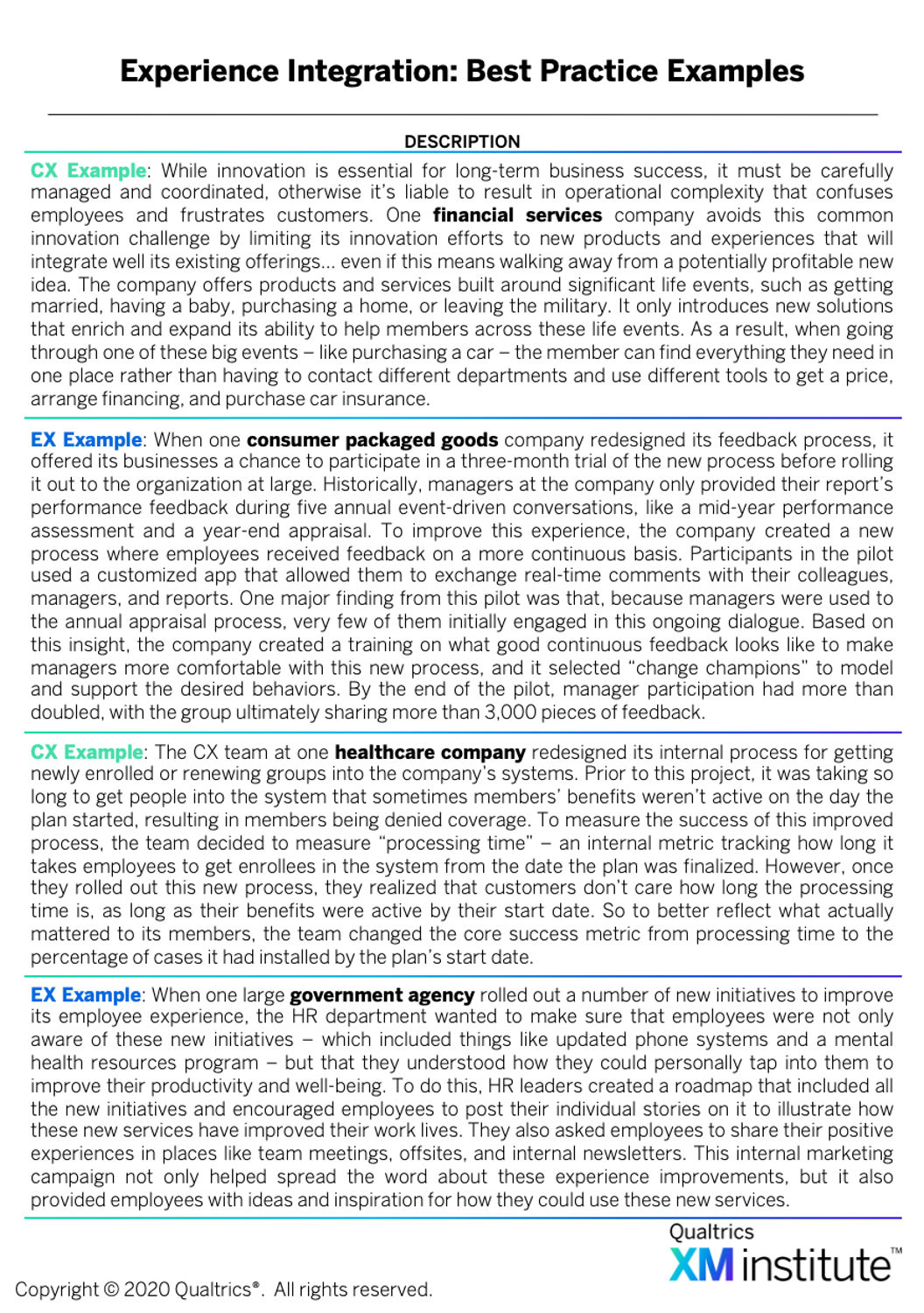 :
:
- Prepare for operational changes. Any disruptive new experience will require some people across the organization to change how they perform their everyday jobs. However, organizations often get so caught up in making sure a new solution works and it resonates with target users that it forgets to build the internal structures, training, and processes that are necessary for a smooth delivery. To ensure that all relevant employees and partners are prepared to support the new experience, organizations should proactively develop the communications and training required for people across the organization to understand not only why the new experience is important, but also how it will be rolled out and what changes they should expect to see to their individual roles
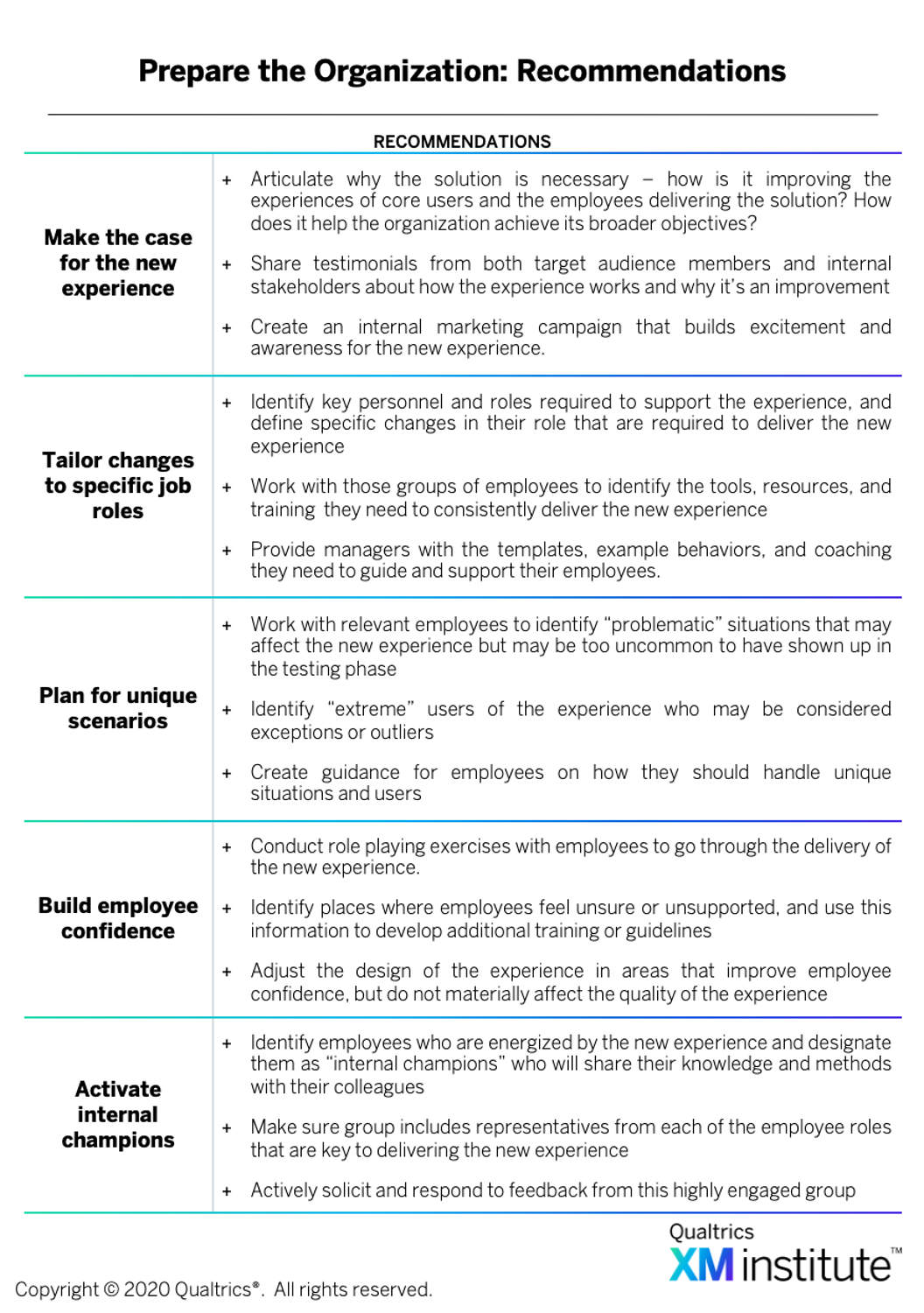 . This step is critical for avoiding unintended confusion or conflicts and building internal advocates for the experience improvements.
. This step is critical for avoiding unintended confusion or conflicts and building internal advocates for the experience improvements. - Learn from pilots. Instead of immediately rolling a new experience out to the entire market, begin by launching a pilot of the new solution to only a small group of people, including members of the target audience and a subset of the employees or partners who will be delivering the experience. Unlike in Experience Design where the team is testing ideas for the new experience, here it is testing the entire system around the new experience to ensure it is desirable, technologically feasible, and economically viable. During the pilot, the team should assess how it reacts to market forces, how well it integrates with the rest of the company’s portfolio, how it performs in different operational conditions, and how effectively the organization’s internal processes, resources, and structures are supporting the experience. Based on these findings, the team needs to be prepared to adjust, not only the solution, but things like employee training and enablement, marketing messages and collateral, listening posts, customer support infrastructure, operational processes, and so on. As the organization collects information and further refines the engagement model, it will gradually roll the new experience out to a broader and broader audience until it is fully deployed in the market.
- Monitor the new experience. The process of creating a differentiated experience is not finished once it’s been fully deployed. The organization needs to continue to monitor the reactions to this new experience – both from the people consuming the experience and the people delivering and supporting the experience – and keep the required resources on hand to make rapid adjustments based on what it’s observing. To do this effectively, the organization should develop a plan prior to launch that outlines how it’s going to collect, distribute, and respond to feedback about this new experience. As part of this plan, it needs to define meaningful, measurable indicators of success. These should be a mix of experience data (X-Data) – such as customer effort score or employee satisfaction with a new training – and operational data (O-data) – like Average Time on Page or percentage of employees who complete the training. The design process is only truly finished when everyone – from target users to employees to business leaders – are all satisfied that the solution is consistently delivering the desired experience at the required level of scale.





